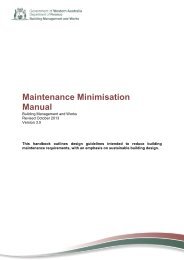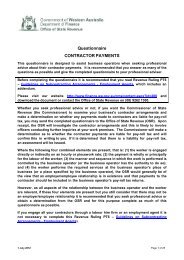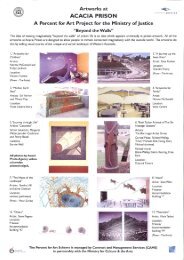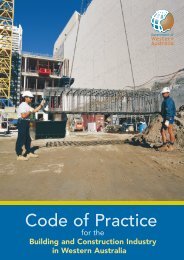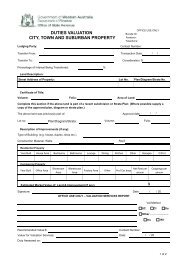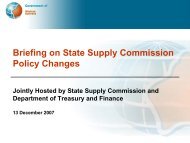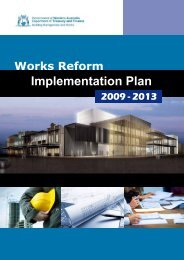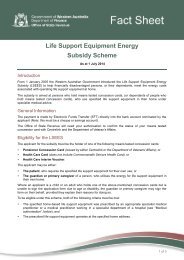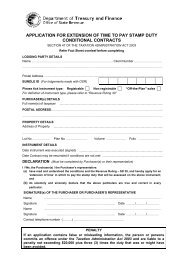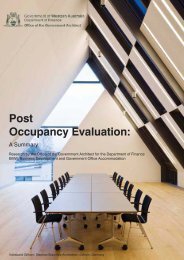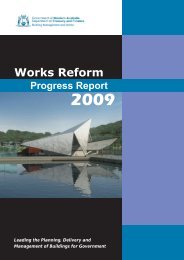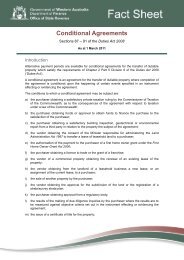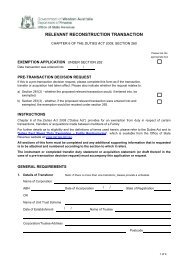Renewable Energy Handbook 2010 - Department of Finance - The ...
Renewable Energy Handbook 2010 - Department of Finance - The ...
Renewable Energy Handbook 2010 - Department of Finance - The ...
Create successful ePaper yourself
Turn your PDF publications into a flip-book with our unique Google optimized e-Paper software.
Wood represents 3.1 per cent <strong>of</strong> Australia’s totalprimary energy consumption. Most <strong>of</strong> the heat energythat is produced is consumed as fi rewood in theresidential sector. <strong>The</strong> remaining heat energy is usedin the wood products, paper and food industries.Western Australia has several sources <strong>of</strong> bioenergyresources that could be developed further:Forestry and tree crop resources include residues·from forestry plantations and the potential newwoody crops for wheat belt agriculture, such as oilmallee; agricultural crops which have high starch/sugar content (such as cereals and sugar cane),or herbaceous annual crops which have high oilcontent (sunfl owers or canola). <strong>The</strong> waste fromthese crops can be used in the production <strong>of</strong>transport fuels (ethanol and biodiesel).Animal wastes, classifi ed as wet wastes, can be·ideal feedstocks for anaerobic digestion. <strong>The</strong> mostcommonly used animal wastes are manures frompigs, chickens and cattle (in feedlots). As theseanimals are reared in confi ned spaces, and thusgenerate a large amount <strong>of</strong> waste in a small area,these resources are ideal for bioenergy generation.Meat processing and abattoir wastes are alsopotential resources, for example tallow can beused as a feedstock for biodiesel.Industrial wastes – the food industry produces a·large number <strong>of</strong> residues and by-products that canbe used as bioenergy energy sources. Dry wastesinclude peelings and scraps from fruit andvegetables, food that does not meet quality controlstandards, pulp and fi bre from sugar and starchextraction, fi lter sludges and c<strong>of</strong>fee grounds.···OFFICE OF ENERGYRENEWABLE ENERGY HANDBOOK <strong>2010</strong>Dry wastes may be suitable for direct combustion,gasifi cation or pyrolysis. Wet industrial wastestreams are generated by washing meat, fruit andvegetables, blanching fruit and vegetables,pre-cooking meats, poultry and fi sh, cleaning andprocessing operations and wine making. <strong>The</strong>sewaste waters contain sugars, starches and otherdissolved and solid organic matter. <strong>The</strong> potentialexists for these industrial wastes to beanaerobically digested to produce biogas,or fermented to produce ethanol.Municipal Solid (Green) Waste (MSW) can beconverted into energy by direct combustion,gasifi cation or through anaerobic digestionoccurring when the material is disposed in alandfi ll. In Western Australia there are a number<strong>of</strong> landfi ll gas plants. <strong>The</strong> gas produced at thesesites through the anaerobic decomposition <strong>of</strong>MSW (approximately 50 per cent methane and50 per cent carbon dioxide) is collected from thestored material and scrubbed before feeding intointernal combustion engines or gas turbines togenerate heat and power.Sewage <strong>Energy</strong> can be extracted from sewageusing anaerobic digestion to produce biogas.<strong>The</strong> sewage sludge that remains can then becombusted or undergo gasifi cation or pyrolysisto produce more biogas and ‘bio-oil’.Table 7 provides some current examples <strong>of</strong>bioenergy projects in Western Australia.TABLE 7. EXISTING AND PROPOSEDBIOENERGY PROJECTS IN WESTERN AUSTRALIA57RENEWABLE ENERGY IN WESTERN AUSTRALIAPROJECTPROPONENTCAPITAL(MW)START DATELandfi ll gas (produced from the anaerobicdecomposition <strong>of</strong> commercial, industrial anddomestic wastes) at Redhill, Canning Vale, MtClaremont, Kalamunda and Tamala ParkLandfi ll Gas and Power12.3 MW(total capacity)1995 – 2004Woodman Point Wastewater Treatment Plant: Water Corporation 1.8 1998Manjimup Bioenergy power facility Western Australian Bioenergy 40 Late <strong>2010</strong>Perth metropolitan (2 sites) landfi ll gas project Landfi ll Management Services 4.4 –Perth metropolitan (1 site) landfi ll gas project Waste Gas Resources 2.1 –Landfi ll gas extraction and generation site:AGL <strong>Energy</strong> Services Pty LtdGosnellsRockingham2.11.62003



